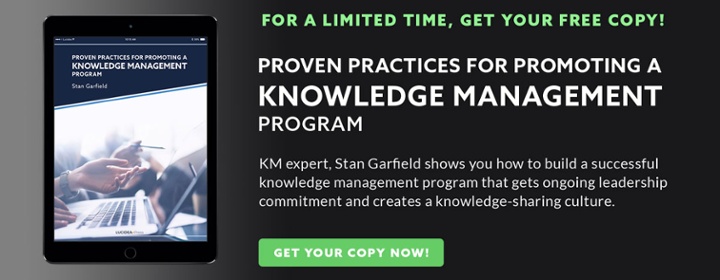
The single most important “KM sale” you can make is to your senior leaders. If you get them on board, everything else will be much easier. If you can’t, you need to keep trying until you do. To get their sponsorship and support, tell stories, make the business case, and sell the benefits. Please read on to learn about effective storytelling, drawn from my new book Proven Practices for Promoting Knowledge Management.
Storytelling is a very useful tool to help obtain leadership commitment as you promote your KM program.
Proven practices for storytelling
Before launching a KM program, tell stories that show the value it will provide. After the program starts, tell stories of early success. As the program matures, memorialize wins in the voices of actual users.
In The Leader’s Guide to Storytelling, Steve Denning defines eight narrative patterns of organizational storytelling. Three are especially relevant to selling KM:
- Motivate others to action: use narrative to ignite action and implement new ideas. The challenge of igniting action and implementing new ideas is pervasive in organizations today. The main elements of the kind of story that can accomplish this–a springboard story–include the story’s foundation in a sound change idea, its truth, its minimalist style, and its positive tone.
- Get others working together: use narrative to foster collaboration that gets things done. The different patterns of working together include work groups, teams, communities and networks. Whereas conventional management techniques have difficulty in generating high-performing teams and communities, narrative techniques are well suited to the challenge.
- Create and share your vision: use narrative to lead people into the future. Future stories are important to organizations, although they can be difficult to tell in a compelling fashion since the future is inherently uncertain. The alternatives available to a leader in crafting the future story include telling the story in an evocative fashion and using a shortcut to the future. Others include simulations, informal stories, plans, business models, strategies, scenarios and visions.
Storytelling should be incorporated in many KM implementation steps, activities, and components. Remember that the effectiveness of education and communication will be enhanced through the use of narratives rather than dry bullet points. For example, instead of creating the usual PowerPoint slides to present your KM program, tell stories about some typical users and the ways they apply the components of the KM program to help them do their jobs.
Lucidea Press has published my latest book, Proven Practices for Promoting a Knowledge Management Program, which includes additional information on obtaining leadership commitment, and many insights drawn from my career as a KM practitioner.



